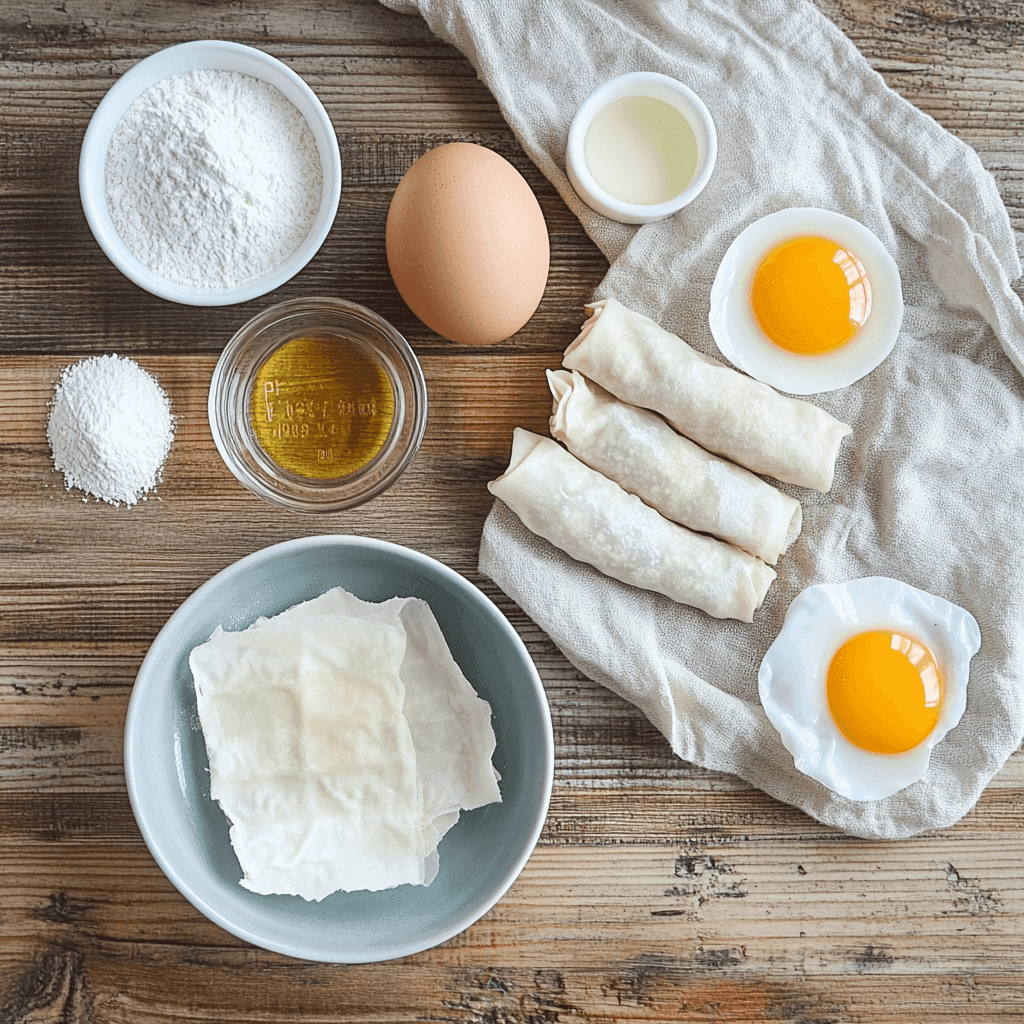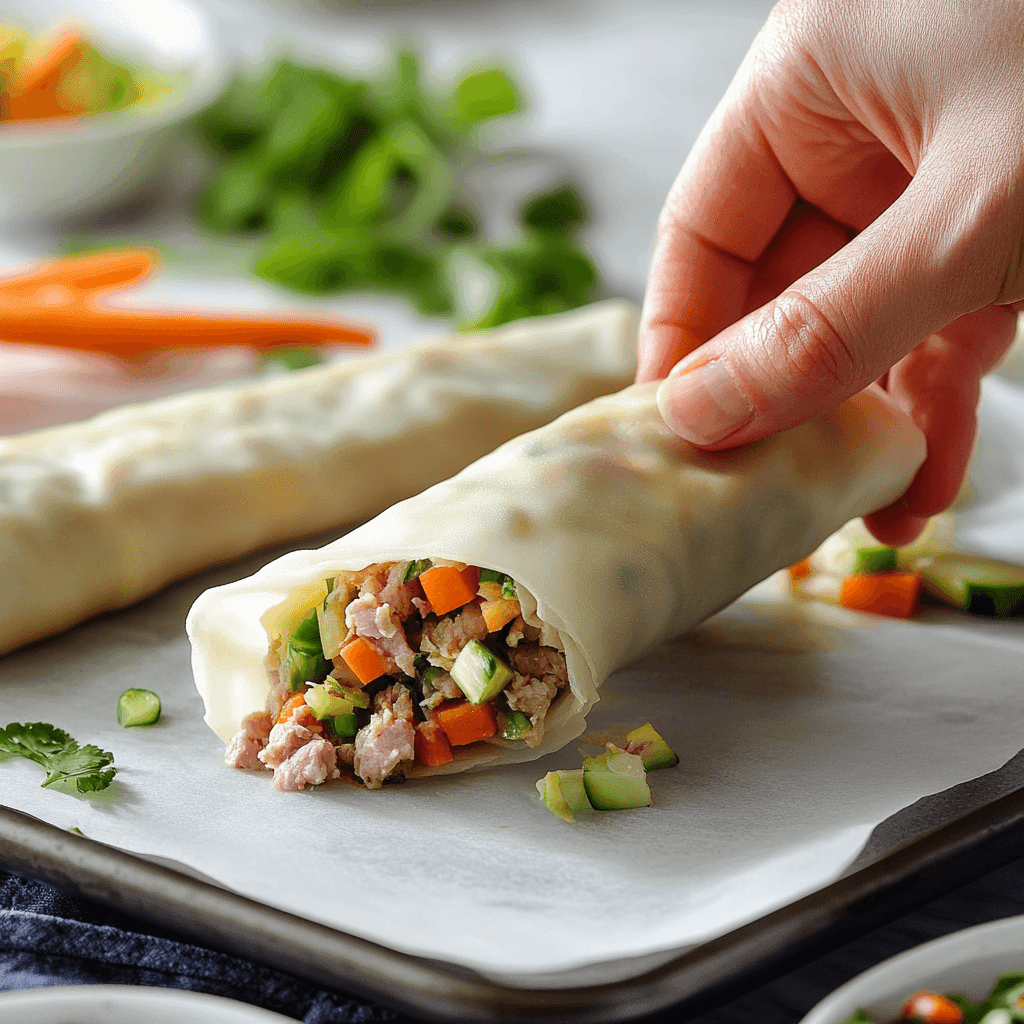Making gluten-free egg roll wrappers at home is surprisingly easy. With the right ingredients and cooking methods, you can make delicious and crispy Gluten-Free Egg Roll Wrappers. These are perfect for many fillings. You can also customize them to fit your taste and dietary needs.
High-quality egg roll wrappers are key for a great meal. Making them at home lets you control the ingredients. This ensures they are truly gluten-free. They should be about 7″x7″ and filled with about 2 tablespoons of your favorite ingredients.
Table of contents
Key Takeaways
- You can customize your gluten-free egg roll wrappers with various fillings to suit your taste and dietary needs.
- Making gluten-free egg roll wrappers at home is faster than ordering takeout and allows for healthier options.
- Gluten-free flour blends should include xanthan gum for texture, and rice paper wrappers are a great gluten-free alternative.
- Egg rolls can be stored in an airtight container for 3-4 days, and a variety of dipping sauces can enhance the experience.
- Using 90% lean ground beef and cooking it for approximately 5 minutes can provide a healthier filling option.
- Maintaining an oil temperature of 350°F-375°F is crucial for optimal frying results.
Understanding Gluten-Free Egg Roll Wrappers
Gluten-free Asian recipes are popular, and easy gluten-free egg rolls are a favorite. But, traditional egg roll wrappers have gluten, which is bad for those with gluten issues. Luckily, you can make your own gluten-free egg roll wrappers that taste great and are crispy.
To make these wrappers, use tapioca or potato starch. These add texture and make the wrappers stretchy. Tapioca starch makes them stretchy, so they don’t break when rolled. Potato starch makes them crispy after cooking, just like traditional ones.
What Makes Traditional Egg Roll Wrappers Not Gluten-Free
Traditional egg roll wrappers have wheat flour, which has gluten. This is a problem for people with gluten issues. But, many brands now offer gluten-free options. These are made with rice flour or corn flour.
The Science Behind Gluten-Free Alternatives
Gluten-free wrappers are made with special starches and flours. These ingredients give the wrappers the right texture and structure. This way, you can make your own wrappers that are tasty and safe for those with gluten issues.
Benefits of Making Your Own Wrappers
There are many good reasons to make your own egg roll wrappers. You can pick the ingredients and make them the size and shape you want. It’s also cheaper and easier to do than buying them. Plus, you can store them in the fridge or freezer for later. For a tasty dipping sauce, check out this website for a simple recipe.
Essential Equipment for Making Gluten-Free Wrappers
To start gluten-free cooking, you need the right tools. Making gluten-free egg roll wrappers is easier with the right equipment. This ensures your wrappers are perfect and makes cooking fun.
A rolling pin is key for rolling out dough to the right thickness. A sharp knife is needed for cutting the wrappers. Also, a wok or large skillet is essential for cooking, like in stir-fries or pan-fried dumplings.
Having the right tools is crucial for gluten-free cooking. Here are the main pieces you’ll need:
- A rolling pin for rolling out the dough
- A sharp knife for cutting the wrappers
- A wok or a large skillet for cooking
Investing in these tools will help you make delicious gluten-free dishes. Perfect gluten-free egg roll wrappers are just the start. The right tools make cooking more fun and the results better.
With the right tools and practice, you’ll master making gluten-free wrappers. This opens up a world of gluten-free food options for you to try and enjoy.
| Equipment | Description |
|---|---|
| Rolling Pin | For rolling out the dough to the perfect thickness |
| Sharp Knife | For cutting the wrappers into the desired size and shape |
| Wok or Large Skillet | For cooking the wrappers, specially for stir-fries or pan-fried dumplings |
Required Ingredients and Their Purpose

When making gluten-free egg roll wrappers, picking the right ingredients is key. You need gluten-free flour, binding agents, and additives. Rice flour, cornstarch, and tapioca flour are good choices for gluten-free flours.
For gluten-free Asian recipes, like egg rolls, choosing the right ingredients is crucial. Eggs and xanthan gum help the wrapper stick together. Salt and sugar add flavor. You can also use sesame oil or soy sauce for a special taste.
- Gluten-free flour options: rice flour, cornstarch, tapioca flour
- Binding agents: eggs, xanthan gum
- Additives: salt, sugar, sesame oil, soy sauce
Gluten-Free Flour Options
Choosing the right gluten-free flour is important for egg roll wrappers. Rice flour, cornstarch, and tapioca flour are good options. Each flour has its own benefits, so try different ones to find what works best.
Binding Agents and Additives
Eggs and xanthan gum help the wrapper stick together. Salt and sugar add flavor. You can also add sesame oil or soy sauce for a unique taste.
Preparing Your Workspace for Success
To make delicious homemade egg roll wrappers, you need a clean and floured surface. Also, have all your equipment and ingredients ready. A well-organized workspace is key for gluten-free cooking, helping you achieve the perfect texture and flavor.
Begin by clearing a large area on your countertop and dusting it with gluten-free flour. This prevents your wrappers from sticking and makes them easier to handle. Next, gather all the ingredients, including gluten-free flour, water, and any fillings you want. Having everything ready saves time and reduces stress while cooking.
Here are some tips to help you prepare your workspace:
- Use a large, clean surface to work on
- Dust the surface with gluten-free flour to prevent sticking
- Gather all necessary ingredients and equipment within reach
- Keep a bowl of water nearby to help with dough handling
By following these simple steps, you’ll be well on your way to creating delicious homemade egg roll wrappers. Stay organized and don’t be afraid to try different fillings and flavors to find your favorite.
With a little practice and patience, you’ll be making homemade egg roll wrappers like a pro. Happy cooking!
| Ingredient | Quantity | Purpose |
|---|---|---|
| Gluten-free flour | 2 cups | Main ingredient for wrappers |
| Water | 1 cup | Helps to bind dough together |
| Salt | 1/4 teaspoon | Enhances flavor |
Mixing and Kneading the Perfect Dough
To make tasty gluten-free food, like easy gluten-free egg rolls, mixing and kneading the dough is key. You need to get the dough right, fix common problems, and know when to rest it. With 12308 shares of the recipe for homemade gluten-free egg roll wrappers, many are eager to try making their own.
To mix the dough, combine 200 g of all-purpose flour, 300 ml of water, and 1/2 tsp. of salt. The dough takes about 25 minutes to prepare, with 10 minutes for prep and 15 for cooking. For more gluten-free recipe ideas, check out gluten-free chicken noodle soup.
For perfect gluten-free egg roll wrappers, aim for a thin, paper-like texture. Roll the dough to 2 millimeters thickness. Each wrapper cooks for about 10 seconds over a slightly hotter fire after slow cooking. Using a gluten-free flour mix, like white rice flour and potato starch, can make things easier.
Achieving the Right Consistency
Getting the dough right is crucial for gluten-free egg roll wrappers. It should be thin and easy to work with, but not too sticky or dry. Adjust the dough by adding water or flour as needed. Remember, different gluten-free flours can have different textures.
Troubleshooting Common Dough Problems
Dealing with sticky or dry dough is easy. For sticky dough, add more flour. For dry dough, add more water. These tips will help you make delicious gluten-free egg rolls for any event.
| Ingredient | Quantity |
|---|---|
| All-purpose flour | 200 g |
| Water | 300 ml |
| Salt | 1/2 tsp. |
Rolling and Shaping Techniques
To get the perfect shape for your gluten-free Asian recipes, like appetizers, you need to learn how to roll and shape. When rolling out the dough, be gentle to avoid making it tough. You can use a rolling pin or your hands to make thin circles.
Here are some tips for rolling and shaping:
- Use a lightly floured surface to prevent the dough from sticking.
- Apply gentle pressure to avoid developing the gluten.
- Use a consistent motion to roll out the dough to an even thickness.
After rolling out the dough, you can shape it into different forms. For appetizers, you can make triangles or squares. Just fold the dough over the filling and press the edges to seal.
By using these techniques, you can make delicious gluten-free Asian recipes, including appetizers. With a bit of practice, you’ll get the dough to the perfect shape and size for your egg roll wrappers.
| Technique | Description |
|---|---|
| Rolling | Use a gentle touch to roll out the dough to an even thickness. |
| Shaping | Fold the dough over the filling and press the edges together to seal. |
How to Test Your Wrapper’s Flexibility
To make sure your high-quality egg roll wrappers are great for filling and cooking, test their flexibility. You can do this with a simple fold test. Just fold the wrapper in half and then unfold it.
If it folds easily without cracking, it’s flexible and ready to use. This is a good sign.
Another way to check is by looking for perfect texture. A good wrapper should feel smooth and even. It shouldn’t be too thick or too thin.
You can also stretch it gently to see if it snaps back into shape. If it does, it’s made with quality ingredients.
Testing your wrapper’s flexibility and texture ensures it’s perfect for cooking. This way, you can make delicious dishes that everyone will enjoy.
Storage and Preservation Methods
Storing gluten-free egg roll wrappers requires careful attention. You want them fresh for any occasion. Follow the right steps for refrigeration, freezing, and thawing.
Cooked egg rolls can stay at room temperature for 2 hours. Uncooked ones should not be out for more than 1 hour. Cooked ones can last 3-4 days in the fridge, and uncooked ones about a week. Frozen egg rolls can stay good for up to 6 months.
Refrigeration Guidelines
For fridge storage, use an airtight container. They can last 3-4 days. Always check for mold, color changes, or bad smells before eating.
Freezing Instructions
Freezing is great for keeping wrappers fresh. Lay them flat on a baking sheet, then bag them up. They can last 6 months in the freezer. Just thaw and cook when you’re ready.
Thawing Procedures
To thaw, leave them in the fridge overnight or thaw at room temperature for a few hours. After thawing, use them right away or store in the fridge for 3-4 days.
These tips help keep your gluten-free egg roll wrappers fresh longer. They’re useful for both experienced cooks and beginners. Enjoy your gluten-free food options with these storage tips.
| Storage Method | Shelf Life |
|---|---|
| Refrigeration | 3-4 days |
| Freezing | Up to 6 months |
| Room Temperature | Up to 2 hours |
Creating Different Sized Wrappers for Various Recipes
To make easy gluten-free egg rolls, you need to create different sized wrappers. The size depends on the filling and cooking method. For example, egg rolls need larger wrappers than spring rolls or wontons.
Here are some tips for adjusting the size of your homemade egg roll wrappers:
- Use a larger circle of dough for egg rolls, about 4-5 inches in diameter.
- Use a smaller circle of dough for spring rolls, about 3-4 inches in diameter.
- Adjust the thickness of the dough to achieve the right texture and flexibility.
By creating different sized wrappers, you can make a variety of dishes. From easy gluten-free egg rolls to spring rolls and wontons. Experiment with different sizes and fillings to find your favorite combinations. With homemade egg roll wrappers, you can enjoy delicious and gluten-free Asian-style dishes at home.
Common Mistakes to Avoid
When making gluten-free egg roll wrappers, it’s key to avoid common mistakes. These can affect the texture and taste of your final product. To ensure your gluten-free Asian recipes are perfect, watch out for temperature control issues, texture problems, and rolling mistakes. Follow simple tips and guidelines to avoid these mistakes.
For instance, when making gluten-free appetizers, keeping the right temperature and humidity is crucial. This prevents the wrappers from becoming too dry or too moist. Store the wrappers in an airtight container and keep them away from direct sunlight.
Some common mistakes to watch out for include:
- Overworking the dough, which can lead to a dense and chewy texture
- Not resting the dough long enough, which can cause the wrappers to tear easily
- Rolling the wrappers too thinly, which can make them prone to breaking
By avoiding these common mistakes, you can create delicious and authentic gluten-free Asian recipes. These include gluten-free appetizers perfect for any occasion. Always use fresh and high-quality ingredients, and follow the recipe instructions carefully for the best results.
To improve your gluten-free egg roll wrapper-making skills, try experimenting with different ingredients and fillings. This will help you create unique and tasty gluten-free Asian recipes. With practice and patience, you can master the art of making gluten-free egg roll wrappers. Enjoy delicious and healthy gluten-free appetizers anytime.
Common Mistakes and Solutions
| Mistake | Solution |
|---|---|
| Overworking the dough | Rest the dough for at least 30 minutes before rolling |
| Not resting the dough long enough | Let the dough rest for at least 2 hours before rolling |
| Rolling the wrappers too thinly | Roll the wrappers to a thickness of at least 1/16 inch |
Recipe Variations and Adaptations

Gluten-free cooking opens up a world of possibilities. You can make unique fillings for your gluten-free egg roll wrappers. Try using lean ground turkey or tofu with veggies like cabbage and carrots.
Finding the right mix of flavors and textures is key. Add fresh herbs like mint and spices like ginger to your fillings. Use coconut aminos or tamari instead of soy sauce for a rich taste.
Here are some tips to get you started:
- Experiment with different types of gluten-free flours, such as white sorghum flour or garbanzo bean flour, to create unique textures and flavors.
- Try using various cooking methods, such as steaming or pan-frying, to achieve the perfect crispiness and tenderness.
- Don’t be afraid to add your own favorite ingredients, such as diced onions or chopped bell peppers, to create a personalized flavor profile.
By exploring gluten-free cooking, you can make delicious and innovative dishes. Don’t be afraid to try new ingredients and cooking methods. Your taste buds will love it!
Conclusion
Making gluten-free egg roll wrappers at home is a fun and rewarding task. You can make high-quality wrappers for many fillings and recipes. These wrappers are great for those with dietary needs or anyone who loves homemade food.
Success comes from learning how to make the dough, roll it, and store it. Try different flours, binders, and extras to find your favorite. Don’t hesitate to try new flavors and fillings. The world of egg rolls is full of possibilities.
Keep exploring and learning as you make gluten-free egg roll wrappers. Enjoy the journey, learn from mistakes, and celebrate your successes. Sharing your creations with others will surely bring happiness to your gatherings.
So, start your tasty journey to making authentic gluten-free egg roll wrappers. They will impress and please everyone. Bon appétit!
FAQ
What makes traditional egg roll wrappers not gluten-free?
Traditional egg roll wrappers are made with wheat flour. Wheat flour has gluten, which is not okay for a gluten-free diet.
What are the benefits of making your own gluten-free egg roll wrappers?
Making your own wrappers lets you pick the ingredients. This ensures they fit your dietary needs. Plus, you get to make high-quality wrappers for all sorts of fillings.
What essential equipment is needed to make gluten-free egg roll wrappers?
You’ll need a rolling pin, a sharp knife, and a wok or large skillet. These tools help with rolling, cutting, and cooking the wrappers.
What are the best gluten-free flour options for making egg roll wrappers?
Good options include rice flour, tapioca flour, and gluten-free flour blends. Almond flour or coconut flour can add the right texture and flexibility.
How do I achieve the right consistency when mixing and kneading the dough?
Getting the dough right is key. Pay attention to common problems and follow the right resting times. This ensures your wrappers turn out well.
How do I test the flexibility of my gluten-free egg roll wrappers?
Do a simple fold test to check the wrappers. Look for signs of a good texture. The wrapper should fold without cracking or breaking.
How should I store and preserve my homemade gluten-free egg roll wrappers?
Storing and preserving your wrappers is important. Follow refrigeration, freezing, and thawing tips. This keeps them fresh and ready to use.
Can I create different sized wrappers for various recipes?
Yes, you can make wrappers of different sizes. This is great for different fillings and cooking methods. It lets you try new and tasty recipes.
What are some common mistakes to avoid when making gluten-free egg roll wrappers?
Avoid temperature control, texture, and rolling mistakes. Knowing how to fix these issues helps make perfect wrappers.

